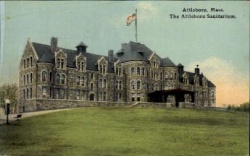Attleboro Sanitarium
| Attleboro Sanitarium | |
|---|---|
 | |
| Established | 1894 |
| Opened | 1903 |
| Demolished | 2000 |
| Current Status | Demolished |
| Building Style | Single Building |
| Alternate Names |
|
History
Timeline
1894, Spring: In Attleboro, MA, James M. Solomon, long to be known as an Indian Doctor (but who, in fact, was neither an American Indian nor a medical doctor), was gathering herbs and roots in the woods on this property; he was a medicine man, who concocted and peddled herbal remedies; he dreamed of a great sanatorium which he would one day build on this very spot; here people would come from all corners of the world to be healed ... cured of that dread disease, cancer.
1894, Summer: O. F. Higgins, a civil engineer, was engaged to survey and lay out these grounds; he was also commissioned to trace out the position of a great stone building of Dr. Solomon's dreams.
1895, Summer: In Attleboro, drives, lawns, and gardens materialize around the site of the longed for sanatoruim; the available funds run out.
1901, March: O.F. Higgins completes architect's plans for the Attleboro sanatorium; soon the walls stood in place ready and waiting to receive the giant roof; John M. Fisher, a local businessman, at this point, was smitten by Dr. Solomon's dream and pledged the necessary financial backing; the sanatorium cost $400,000 to build.
1902: Fisher and a number of Attleboro businessmen formed the Solomon Sanatorium Company.
1903, April 25: Dedication of Solomon's Sanatorium; statistics given in the printed program distributed that day include: “Bricks 475,709 of which 250,000 are enamel; windows, 309; panes of glass, 3,254; fireplaces, 21; rooms, 200; electric wire, 27 miles; power, lighting, and heating plant in duplicate to provide for accident."
1903, May 16: With Herbert B. Horton, M.D., as house physician the dream finally became a reality as patients were admitted.
1906: Lack of funds forced the closing of the Solomon Sanatorium
1908, June: A family of doctors named Nicola from Battle Creek, MI reopened the Attleboro Sanatorium; it flourished “for the relief of suffering humanity” till 1918
1911: The vacationing Dr. Charles C. Nicola mysteriously disappears on his return voyage from Bermuda. His wife Dr. Mary Nicola continues to run the Sanitarium with the help of other members of the Nicola family.
1918, Summer: the Solomon Sanatorium folded up
1919: The Methodist Church inaugurated the Centenary Movement; Mr. John Fisher gave the Solomon Sanatorium to the Methodist Board of Foreign Missions; which called Dr. Herbert G. Vaughan from Kentucky, to take charge and changed the name to Attleboro Springs
1920, July 24: Death of Mr. John Fisher; maintaining and operating Attleboro Springs soon became a losing struggle
1924, October: Methodist Board of Foreign Missions closed the Sanatorium
1927: Mission Board prevailed upon the New England Deaconess Association to take over the Springs; the Rev Clarence D. Pierce was appointed superintendent; $30,000 spent on restoration
1934, July: Thomas J. Griffin, retired and well-to-do businessman, gave the Springs a shot in the arm, new health care programs were inaugurated, some degree of success ensued; funding once again became a problem and Attleboro Springs took to renting meeting rooms and serving meals for local civic and church groups to supplement its dwindling financial resources
1938, Jan. 1: Attleboro Springs shuts down
1942: La Salettes buy Attleboro Springs as major seminary
1952, Feb. 2: Construction of the Attleboro Shrine announced; statue placed at proposed site
From 1952 until 2000, the property was operated by the Missionaries of Our Lady of La Salette. On Nov. 5, 1999, flames broke out in a room on the third floor of the majestic, three-story romanesque revival structure known as The Castle. Within minutes, the blaze had spread to the attic and quickly consumed the 100-year-old former sanitarium. A visiting English priest, Paul O'Brien, perished in the flames. The La Salettes decided to not rebuild the structure.

